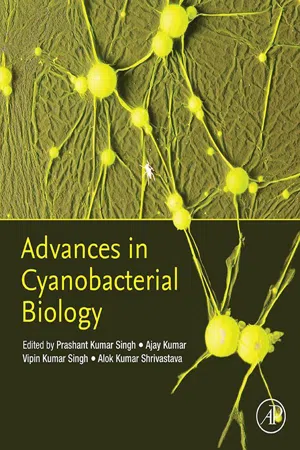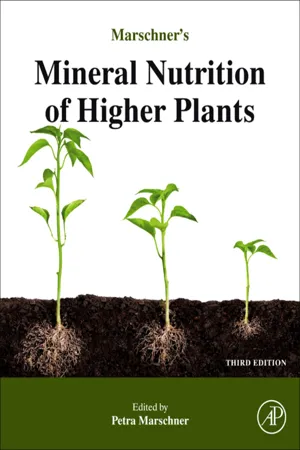Biological Sciences
Photosynthetic Pigments
Photosynthetic pigments are molecules found in the chloroplasts of plant cells and are responsible for capturing light energy during photosynthesis. The main photosynthetic pigments are chlorophyll a, chlorophyll b, carotenoids, and phycobilins. These pigments absorb light of specific wavelengths and transfer the energy to the photosynthetic reaction center, where it is used to drive the process of photosynthesis.
Written by Perlego with AI-assistance
Related key terms
Related key terms
1 of 4
Related key terms
1 of 3
7 Key excerpts on "Photosynthetic Pigments"
- eBook - ePub
- Thomas S. Bianchi, Elizabeth A. Canuel(Authors)
- 2011(Publication Date)
- Princeton University Press(Publisher)
12. Photosynthetic Pigments: Chlorophylls, Carotenoids, and Phycobilins
12.1 Background
The primary Photosynthetic Pigments used in absorbing photosynthetically active radiation (PAR) are chlorophylls, carotenoids, and phycobilins —with chlorophyll representing the dominant photosynthetic pigment (Emerson and Arnold, 1932a,b; Clayton, 1971, 1980). Although a greater amount of chlorophyll is found on land, 75% of the global turnover (ca. 109 Mgyr–1 ) occurs in oceans, lakes, and rivers/estuaries (Brown et al., 1991; Jeffrey and Mantoura, 1997). All of the light-harvesting pigments are bound to proteins, making up distinct carotenoid and chlorophyll–protein complexes. These pigment–protein complexes in algae and higher plants are located in the thylakoid membrane of chloroplasts (Cohen et al., 1995). The photosynthesizing ability of eukaryotes was made possible by one or more endosymbiotic associations between heterotrophic eukaryotes and photosynthetic prokaryotes (or their descendents) (Gray, 1992; Whatley, 1993). Several primary endosymbioses occurred between eukaryotes and cyanobacteria. In one of the lineages, the photosynthetic organism lost much of its genetic independence and became functionally and genetically integrated as plastids—chloroplasts within the host cell (Kuhlbrandt et al., 1994). At least two types of protists—chloroarachniophytes and cryptomonads—acquired plastids by forming symbioses with eukaryotic algae.Photosynthetic organisms have a variety of accessory pigments, on which their classification has been based. Despite this variation, it is generally accepted that all chloroplasts are derived from a single cyanobacterial ancestor. Prochlorophytes are prokaryotes that perform oxygenic photosynthesis using chlorophyll b, like land plants and green algae (Chlorophyta), and were proposed to be the ancestors of chlorophyte chloroplasts. However, three known prochlorophytes (Prochloron didemni, Prochlorothrix hollandica, and Prochlorococcus marinus ) have been shown not to be the specific ancestors of chloroplasts, but only diverged members of the cyanobacteria, which contain phycobilins but lack chlorophyll b (Olson and Pierson, 1987). Consequently, it has been proposed that the ability to synthesize chlorophyll b developed independently several times in prochlorophytes and in the ancestor of chlorophytes. Phylogenetic analyses show that these genes share a common evolutionary origin. This indicates that the progenitors of oxygenic photosynthetic bacteria, including the ancestor of chloroplasts, had both chlorophyll b - eBook - ePub
- Andrew Lack, David Evans(Authors)
- 2021(Publication Date)
- Taylor & Francis(Publisher)
quanta). The amount of energy contained in a photon is inversely proportional to the wavelength, short wavelengths having higher energy than long wavelengths. In order to photosynthesize, plants must convert the energy in light to a form in which it can be used to synthesize carbohydrate.Photosynthetic Pigments
Plants appear green because chlorophyll absorbs blue and red light and reflects green. This can be shown as an absorption spectrum, in which absorbance is plotted against wavelength (Fig. 1). The action spectrum of photosynthesis, i.e. the photosynthetic activity at different wavelengths, is also shown and corresponds to the absorption spectrum.When a chlorophyll molecule is struck by a photon, it absorbs energy. This energizes an electron within the chlorophyll that may be used in photosynthesis or return to its original energy state with a loss of heat and transmission of light of lower wavelength.The major Photosynthetic Pigments are the chlorophylls (Fig. 2). A chlorophyll molecule is made up of a ‘head’ group, a nitrogen-containing porphyrin ring structure, with a magnesium atom at its center, and a tail of hydrocarbons, which anchors the molecule to a membrane. Chlorophyll a is the main pigment of photosynthesis. Most chloroplasts also contain accessory pigments, pigments that broaden the range of wavelengths at which light can be absorbed and that pass the energy obtained to chlorophyll a or protect against damage. Chlorophyll b, carotenoids and xanthophylls are examples of these pigments.Fig. 1. Absorption spectra of three major pigments of photosynthesis: chlorophyll a, chlorophyll b and carotenoids, together with the action spectrum of photosynthesis. The absorption spectrum represents the degree to which the pigment is able to absorb energy at each wavelength of light; the action spectrum represents rate of photosynthesis at each wavelength (Govindjee, unpublished data, 1961; redrawn with permission of Govindjee, University of Illinois at Urbana, Illinois, USA).Fig. 2. The structure of chlorophyll. Chlorophyll b differs from chlorophyll a by the substitution of a CHO group for the - eBook - ePub
Biology
A Self-Teaching Guide
- Steven D. Garber(Author)
- 2020(Publication Date)
- Jossey-Bass(Publisher)
anthocyanins, which are stored in large vacuoles. When autumn approaches, certain sugars are converted to anthocyanin pigments that are red under acidic conditions and blue under alkaline conditions, contributing to the fall colors.PHOTOSYNTHETIC AUTOTROPHS
Unlike organisms known as heterotrophs, which require other plants and animals for their livelihood, autotrophs are organisms that subsist on the inorganic environment. Autotrophs manufacture organic compounds from molecules that are so small, they don't have to be digested. Because the molecules taken in are small enough and sufficiently soluble to pass through the cell membranes, autotrophic organisms do not need to pretreat, break down, or digest their nutrients before taking them into their cells.Photosynthetic autotrophs are among the most important and widespread organisms alive. They have elaborate systems that enable them, with the use of energy from the sun, to raise electrons to an excited state. When the electron is returned to its more normal state, a portion of its energy is transferred to a form where it may be used by the organism.So green plants and other photosynthetic organisms create high-energy organic material through photosynthesis. As described previously, this involves converting carbon dioxide and water, in the presence of light, into carbohydrate, oxygen, and water. Photosynthesis is the ultimate source of all the energy-rich carbon compounds used by all organisms; it is responsible for the continual supply of atmospheric oxygen, without which all the aerobic organisms, those that use oxygen for all their oxidative processes, would not exist. - eBook - ePub
- Jennifer W. MacAdam(Author)
- 2011(Publication Date)
- Wiley-Blackwell(Publisher)
Like other membranes, the thylakoid membranes are made of lipids, although these lipids contain the sugar galactose (making them galactolipids) or sulfate (making a sulfolipid) as the head group, instead of phosphate as in phospholipids. The use of galactolipids in photosynthetic membranes reduces very significantly the amount of phosphorus required by plants and allows photosynthesis to continue under low phosphorus availability. The Photosynthetic Pigments are all hydrophobic to some degree, and therefore are embedded in the lipid bilayer of the thylakoid membranes.Photosynthetic PigmentsThe action spectrum for photosynthesis (Figure 10.2a ), or the range of light wavelengths that result in significant photosynthesis, is an indication of the sum of the absorption spectra of the pigments involved in photosynthesis.ChlorophyllFigure 10.2The action spectrum of photosynthesis (a) shows the relative levels of photosynthesis that occur over the visible light spectrum. The cumulative absorption of the photosynthesis pigments chlorophyll a (b), chlorophyll b (c), and the carotenoids (d) follows the general outline of the action spectrum.Chlorophyll a (chl a ) is the primary pigment for light absorption in photosynthesis (Figure 10.3 ). It consists of a hydrophobic tail that is imbedded in the thylakoid membranes of the chloroplast, and a tetrapyrrole ring composed of four pyrrole rings, each with four carbon atoms and one nitrogen atom. Together, the four pyrrole rings sequester (hold on to) a magnesium atom. Chlorophyll a has two peaks of light absorption, one at a wavelength of 430 nm, in the violet-blue range, and the other at a wavelength of 662 nm, in the red range (Figure 10.2b ). The action spectrum for photosynthesis does not precisely match the absorption spectrum of chlorophyll a , which suggests the involvement of other pigments.Figure 10.3The Photosynthetic Pigments chlorophyll a and b (left) and β -carotene. Chlorophyll has a hydrophobic tail and the entire β - Park S. Nobel(Author)
- 2009(Publication Date)
- Academic Press(Publisher)
aData are expressed per 600 chlorophylls and are for representative leaves of green plants (except for the phycobilins) growing at moderate sunlight levels. Photosystems and the light-harvesting antennae are discussed later in this chapter.5.3. Excitation Transfers Among Photosynthetic Pigments
Chlorophyll is at the very heart of the primary events of photosynthesis. It helps convert the sun's radiant energy into chemical free energy that can be stored in various ways. In this section we will represent light absorption, excitation transfer, and the photochemical step as chemical reactions; this will serve as a prelude to a further consideration of certain molecular details of photosynthesis.5.3A. Pigments and the Photochemical Reaction
The first step in photosynthesis is light absorption by one of the pigments. The absorption event (discussed in Chapter 4 , e.g., Section 4.2E) for the various types of Photosynthetic Pigments described in this chapter can be represented as follows:(5.2)where the asterisk refers to an excited state of the pigment molecule caused by the absorption of a light quantum, hν. Trap chl indicates a special type of Chl a (e.g., P680 or P700 ) that occurs much less frequently than do the other chlorophylls (see Table 5-1 ); we will consider its important excitation-trapping properties at the end of this section.Because the photochemical reactions take place only at the trap chl molecules, the excitations resulting from light absorption by either the accessory pigments or the other Chl a's must be transferred to the trap chl before they can be used for photosynthesis. The relative rarity of trap chl compared with the other Photosynthetic Pigments means that it absorbs only a small fraction of the incident light. In fact, for green plants under natural conditions, over 99% of the photons are absorbed by either the accessory pigments or Chl a. The migration of excitations from the initially excited species to the trap chl—the mechanism for which we will discuss later—can be represented as follows:(5.3) (5.4) In other words, the direction of excitation transfer or migration is from the accessory pigments to Chl a (Eq. 5.3) and from Chl a- eBook - ePub
- Prashant Kumar Singh, Ajay Kumar, Vipin Kumar Singh, Alok Kumar Shrivistava(Authors)
- 2020(Publication Date)
- Academic Press(Publisher)
Dasgupta, 2015 ). The present chapter mainly focuses on the physiochemical characterization of cyanobacterial pigments (including Chls, carotenoids, phycobiliproteins, and scytonemin) and their applications in research and industries.5.2 Chlorophylls
5.2.1 Physiochemical characterizations of cyanobacterial chlorophylls
Chls are photosynthetic pigment found in higher plants, algae, and cyanobacteria. They play a crucial role in “light harvesting” in photosynthesis, a vital process for the survival of both the plant and animal kingdom (Humphrey, 2004 ). Chls selectively absorb light in the red and blue regions and therefore emits green color. Photosynthesis is a process which uses this harvested light energy together with water and carbon dioxide to produce oxygen and carbohydrates; as such, it converts solar energy into chemical energy. Chemically, Chl molecule skeleton has a porphyrin macrocycle which comprises four pyrrole rings (Fig. 5.1 ). Each ring is made of four carbon atoms and one nitrogen atom. All of the nitrogen atoms in the structure face inward with Mg2+ ion binding in the central position (Scheer et al., 2004 ; Cubas et al., 2008 ). An addition of a single isocyclic ring to one of the pyrrole rings makes phorbin structure (Humphrey, 2004 ).Figure 5.1 Chemical structure of cyanobacterial Chls (a , b , d , and f ). Chl , Chlorophyll.Chls are characterized into Chls a , b , c , d , e , and f that are present in a range of photosynthetic organisms such as plants, algae, and cyanobacteria. Among them, most of the cyanobacteria contain Chls a , b , d , and f . Chl a is considered universal Chl as it is present in all the photosynthetic organisms. Also, it is distributed in both the reaction centers (RCs) [photosystem I (PS I); P700 and photosystem II (PS II); P680] and all LHCs. It acts as the primary donor in the RC of PS II and PS I. In PS II monomeric Chl a - eBook - ePub
- Horst Marschner(Author)
- 2011(Publication Date)
- Academic Press(Publisher)
In the chloroplasts these pigment systems are embedded in thylakoid membranes. Often, the thylakoid membranes are stacked into piles which appear as grains or ‘grana’ under the light microscope. The principles involved in the process of electron flow are illustrated in Fig. 5.4. Light energy is absorbed by two pigment systems: photosystem II (PS II) and photosystem I (PS I). In each of these photosystems, between 400 and 500 individual chlorophyll molecules and accessory pigments (e.g., carotinoids) act as ‘antenna’ to trap light energy (photons), which is then transferred to a chlorophyll molecule with maximum absorbance at 680 nm in PS II, and 700 nm in PS I. In both photosystems, the absorption of light energy induces the emission and up-hill transport of two electrons against the electrical gradients. The electrons required for this process are derived from the photolysis of water, mediated by PS II. In higher plants, PS II and PS I act in series (Z scheme; for reviews see Chitnis, 2001 ; Diner and Rappaport, 2002 ; Renger and Renger, 2008). At the end of the up-hill transport chain, the electrons are taken up by an acceptor chlorophyll a molecule (A 0) and transferred through a chain of redox centres that includes phylloquinones (A l) and three Fe-S-clusters (F x, F a and F b) to ferredoxin. The reduced ferredoxin is a strong reductant and is able to reduce NADP + (nicotinamide adenine dinucleotide phosphate), as well as other compounds (see below). Figure 5.4 Photosynthetic electron transport chain with photosystems II and I (PS II; PS I) and photophosphorylation. Pheo: pheophytins; Cyt: cytochrome; F x F a F b : Fe-S-clusters which transfer electrons from primary acceptors (A0, A1) to ferredoxin; XAN: xantophyll cycle. Inset: section of the porphyrin structure of chlorophyll with the central Mg atom. Several nutrients are directly involved in this photosynthetic electron transport chain (Raven et al., 1999 ; Fig. 5.4)
Index pages curate the most relevant extracts from our library of academic textbooks. They’ve been created using an in-house natural language model (NLM), each adding context and meaning to key research topics.
Explore more topic indexes
Explore more topic indexes
1 of 6
Explore more topic indexes
1 of 4






